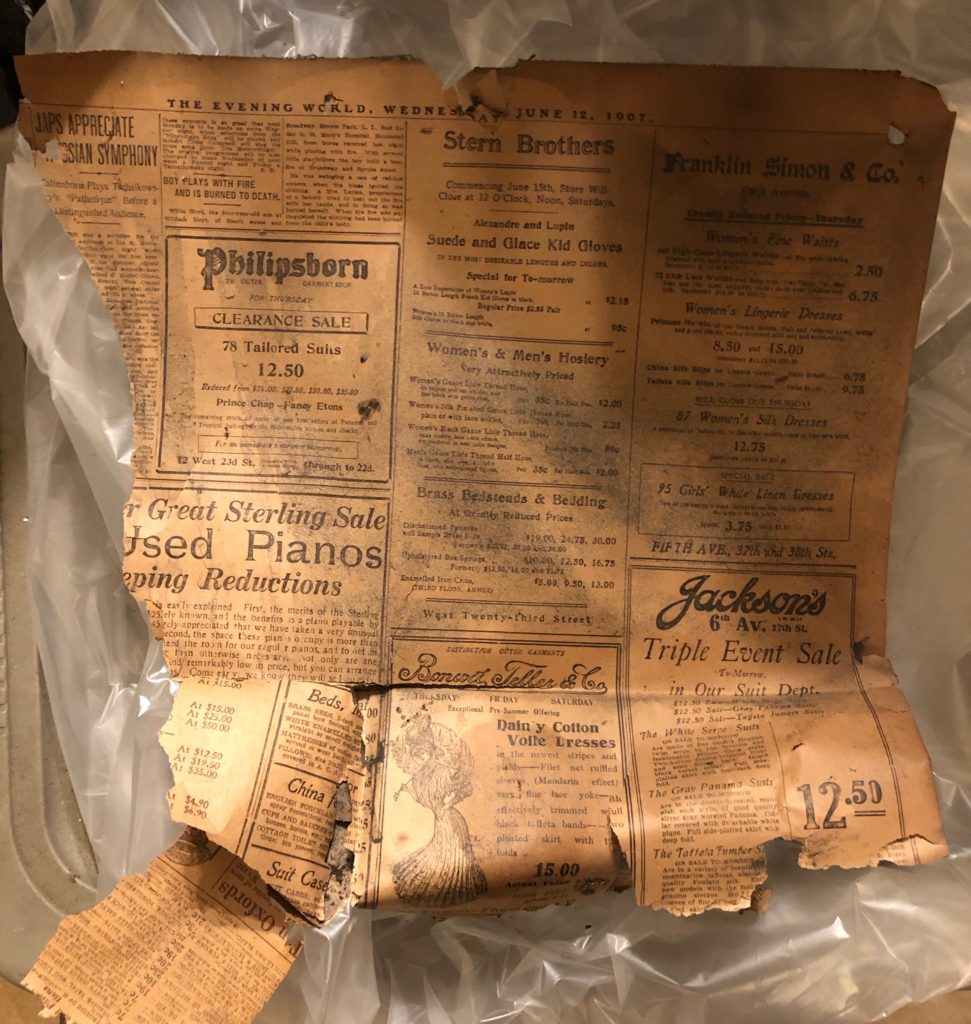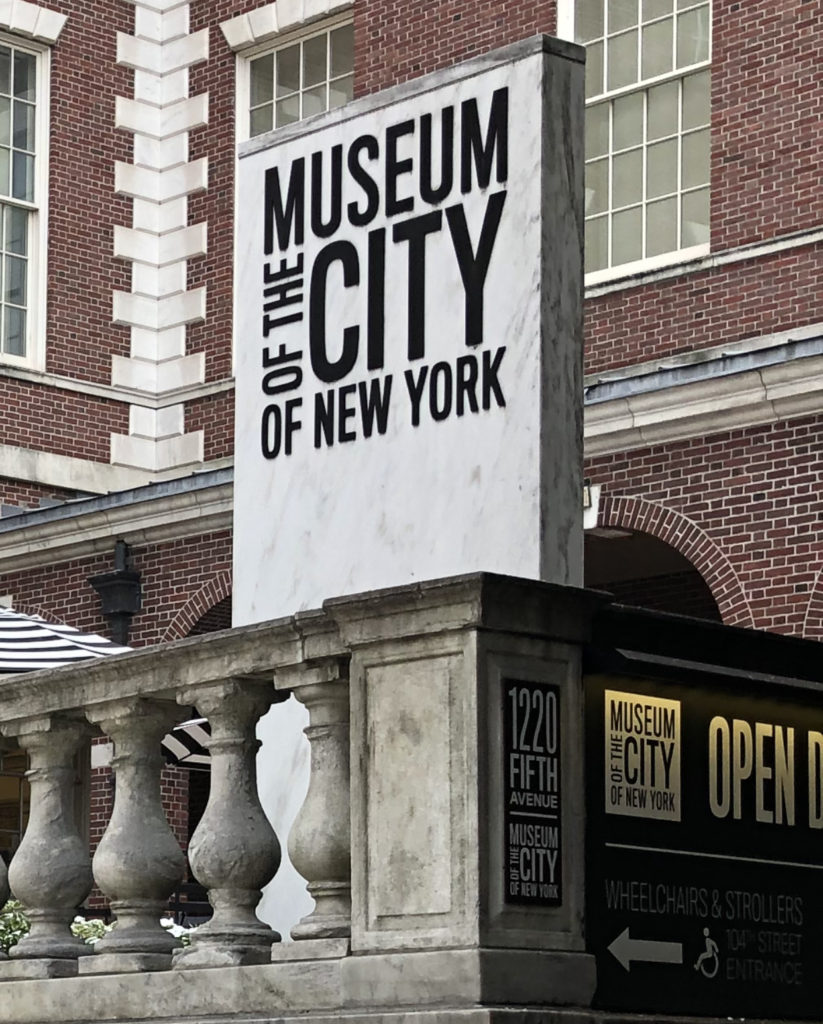Thing: The Evening World Newspaper
Last weekend my family were making repairs to our shed in the backyard. As they took down some of the old wood from the wall, they discovered a piece of an old newspaper. The paper was wet from the condensation in wall and they placed it on a flat surface covered by a black plastic bag to give it time to dry, and protect it from light. Two days passed. I was afraid to damage the paper but, finally I gained the courage to remove the bag to try to inspect what was underneath. It was a newspaper called the Evening World dated Wednesday, June 12, 1907! I was shocked and intrigued. The newspaper was so fragile. I practically came apart in hands, but I managed to get some pictures.

It was amazing to see the types of advertisements for lawyers, dressmakers, medicines, and tinctures. I marveled at the low prices. The biggest story on one of the pages was about roller skaters. It was an article talking about what the New York City Streets would come to if the these “crazed” young people were allowed to take over with roller skates. I mused to myself wondering what the people of that time would think now if the saw all the young folks today on skateboards! I’ve always had an avid curiosity about the past. I’ve read countless stories about the lives of people from different eras. And I was excited to have an actual 112-year-old newspaper in my hands.
Person: Michele Valerie Cloonan
I recently read an article by Michele Valerie Cloonan entitled “W(h)ither Preservation?” Cloonan is a Professor and Dean Emerita at Simmons College. She is also the editor of Preservation, Digital Technology and Culture.
In her article she takes issue with the disappearance of preservation departments in lieu of digital initiatives at various institutions, and she puts forth the question: “Whither we (preservationists) should be going rather than letting these programs die” (Cloonan, 2001). As we move further into the digital era there have been many developments in technology that have allowed new methods of preservation to emerge. But with the new technology there are new concerns. In libraries there are concerns about whether an object should be retained or just the digitized information (Cloonan, 2001). Due to the nature of digitized data, there are also questions about the altering of documents that have been reformatted, as well as, questions with regard to security. Ensuring access points for all this digital information is also an issue that causes some trepidation (Cloonan, 2001).
Place: Museum of the City Of New York

With all these concepts floating around in my head along with my fascinating newspaper discovery, I decided to take a trip to the Museum of the City of New York. I wasn’t sure what I was looking for, but when I arrived, I was pleasantly surprised. I noticed that there was an amazing array of Exhibits that seemed to combine both the tractional museum model of artifact and description combined with new media. There were two exhibits in particular that had lasting effect on me. New York at its Core World City, and the Voice of the Village Exhibit.
NY City at its Core consisted of three presentations: Port City 1609-1898, World City 1898-2012, and Future Lab. The Port city Exhibit was particularly interesting. It was a small display in a darkened room with a series of various interactive displays and digitized maps throughout. In particular there was a virtual display of Mulberry Street. The interactive component allowed the viewer to investigate the photo in great detail. The display allowed you to zoom in on the digitized photo to highlight sections, as well as, find out additional details. The convergence of media to create such a display added to the user experience, and gave what would have been a simple photograph new life.
The Voice of the Village Exhibit was a more traditional exhibit highlighting photographs and print chronicling historic moments in New York City’s history. In light of my recent find, it was poignant to see how the impact of a newspaper could affect how we contextualize events that contribute to how we think about history. The use of the actual newspaper as part of the exhibit also spoke to the importance of using both new technology alongside physical artifacts.

Overall my visit to the Museum of the City of New York was enlightening. I chose this museum specifically to get a better sense of what New York was like during the period the, June 12, 1907, Evening World Newspaper issue was published. It helped me to gain a deeper understanding of the environment, and the factors that lead to what was considered the news for the day. It had been a while since I visited a museum, and I was captivated by the new methods used in the presentation of historical content. These exhibits were a vibrant integration of both the established methods of cultural preservation with leading edge technologies. I found them to be engaging and thought provoking. Cloonan writes: “…we must confront the fact that the experience of using digital documents will be different with each new generation of use” (Cloonan, 2001). While this is true, I believe it is part of the process. Each generation should and will project their own set of values and interpretations onto preserved history to give it broader context. We see this trend happening now in our quest to restructure our own institutions in an effort to become more transparent and inclusive. Furthermore, the digitization of documents will give an extended life to antiquities when they are no longer physically present. Hopefully, with continued interdisciplinary discourse we will find ways to ensure greater security and continued access to these treasures that will engage the public.
In closing, sadly it was too late to save the newspaper we found in the wall. In just a short time of being exposed to the elements it fell apart, but at least (as I stated above) I managed to get some good pictures. I was also able to find a digitized copy of the Evening World through the Library of Congress Website. Interestingly two of the pages I have are not present in the digitized copy. To View the digitized copy click here.
Citations:
Cloonan, M. V. (2001). W(H)ITHER Preservation? The Library Quarterly: Information, Community, Policy, 71(2), 231-242. Retrieved from http://www.jstor.org.ezproxy.pratt.edu:2048/stable/4309507
Library of Congress, June, 12, 1907, Evening World, [Newspaper] Chronicling America: Historic Newspapers, Library of Congress Retrieved from https://chroniclingamerica.loc.gov/lccn/sn83030193/1907-06-12/ed-1/
McDarrah, F.W. (1926-2007), Village Voice Covers, May 23, 1963, Newsprint, Collection of the Estate of Fred W. McDarrah